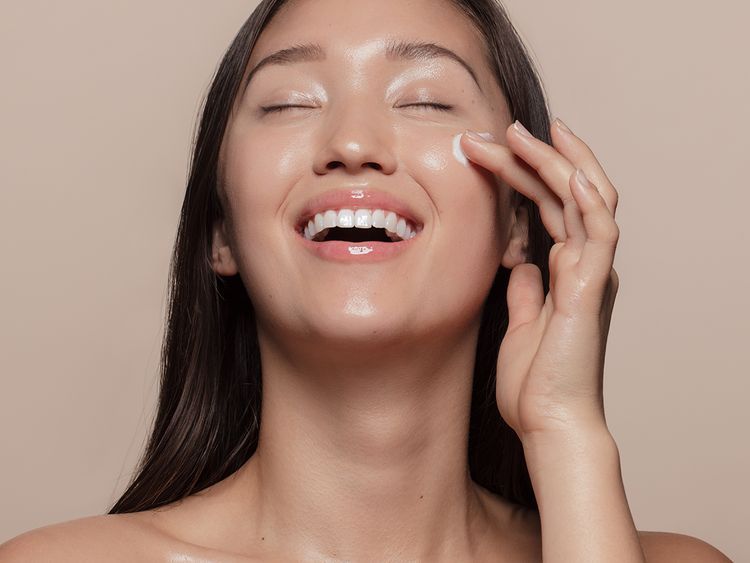
Struggling with blemishes, wrinkles, or uneven skin tone? There's a hidden gem in the world of skincare that tackles them all: Niacinamide! This under-the-radar ingredient might be the missing piece for a radiant, healthy complexion.
Niacinamide has a laundry list of skin benefits. Apart from providing solace when our skin is throwing a tantrum; it has also been shown to brighten, dial down redness, prevent wrinkles, rid the skin of pigmentation, curb oil production and keep the skin barrier strong.
So, what is the best way to use this ingredient? Yes, there’s a right and a wrong way.
Niacinimide 101

For starters, what is niacinamide?
It's a form of vitamin B3 (niacin) that keeps your skin healthy. Experts recommend incorporating it through your diet (think veggies, meat, and nuts) and targeted skincare routines.
Tamara Alizeh, and Parul Thakur,Dubai-based specialist dermatologist explain the benefits of niacinamide. The body requires niacinimide for healthy digestion, improved circulation and brain function. Moreover it has several benefits for skin health, along with powerful anti-inflammatory properties that can improve the skin texture, moisture and application. Thakur adds, "It can help regulate sebum production, which can help combat acne, inhibit transfer of melanin thus reducing pigmentation, improve lipid barrier of the skin aiding in skin hydration and glow. It is a versatile ingredient which is compatible with a lot of other ingredients that can make it a value add to almost any skin care regimen."

Incorporating niacinamide into your skincare routine can offer numerous benefits, from improved barrier function and hydration to anti-aging and anti-inflammatory effects. It regulates sebum production, which can help combat acne, inhibit transfer of melanin, reducing pigmentation, improve lipid barrier of the skin aiding in skin hydration and glow. It is a versatile ingredient....
From stimulating the production of ceramides, keratin and other essentials for a healthy skin barrier to inhibiting hyperpigmentation-causing enzymes, the B3 in niacinamide works magic when applied onto your skin.
Here’s a quick breakdown of its strengths, as explained by Alizeh and Rasika Khanna, a Dubai-based skincare specialist:
Calms the fury: Niacinamide's anti-inflammatory properties soothe redness, which could have developed from chronic inflammatory skin conditions like rosacea, or just generally irritation and over-exfoliation.
Shine under control: Struggling with midday disco-ball vibes? Niacinamide helps regulate oil production, leading to clearer skin. Science agrees – 2006 study by US and Japan-based researchers published in the Journal of Cosmetic and Laser Therapy, found that applying a 2 per cent niacinamide moisturiser showed significantly reduced sebum production rates.
Strong barrier: Dry patches or damage? Niacinamide strengthens your skin's barrier by boosting ceramides. This translates to better hydration and a healthier appearance.
Collagen crew: Get ready for a plumper, younger-looking you! Niacinamide helps your skin ramp up collagen production, and promotes elasticity.
Brightening effects: Niacinamide tackles dark spots by "reversibly blocking" melanin transfer, resulting in an even skin tone.
Sun shield (Bonus!): Niacinamide may even offer some protection against UV rays, potentially reducing wrinkles. In fact, a 2019 study by South Korea based researchers published in the international peer-reviewed journal Biomolecules and Therapeutics showed that niacinamide even improved DNA repair following damage by UV radiation, and protected skin from oxidative stress.
What percentage of niacinimide should I use?

As Alizeh mentions, niacinamide benefits all skin types and ages. However, she does advise caution: If your skin is sensitive, start with lower concentration formulas. You can also use it on alternate days, if any irritation occurs, till your skin becomes used to it.
Shaymaa Metwaly Refaey Metwaly Ibrahim, specialist dermatologist at Saudi German hospital, Dubai had previously explained the breakdown to Gulf News: “Topical two to five per cent formulas of niacinamide can be applied up to two times daily. Oral niacinamide can be given at doses of 1 gram a day to 3 grams a day, your dermatologist will give the dose according to the recommended daily allowance for your age.” In fact, a study published in the International Journal of Dermatology found that 4 per cent niacinamide, applied topically twice daily for eight weeks, significantly improved moderate acne.
However, oral supplements may have side effects such as nausea, vomiting, headache and fatigue, so be sure to check with your dermatologist, first. The experts also advise, that beginning with a high percentage of niacinamide may irritate your skin, so you can start off small and build tolerance.
Which ingredients can you combine with niacinamide?
Niacinamide is a skincare all-star as it plays well with others. It can even soothe the dryness and irritation caused by harsher ingredients like retinoids.
Hyaluronic acid
This dynamic duo tackles dryness head-on. Hyaluronic acid acts like a sponge, attracting and holding onto moisture. Niacinamide strengthens your skin's barrier, preventing that moisture from evaporating, explains Alizeh. This can work wonders for those with dry skin, as both these powerhouses together can alleviate dryness.
Salicylic acid
Salicylic acid is a beta hydroxy acid (BHA) that can penetrate deep into your pores. While it is beneficial for exfoliation and reducing sebum production, it can sometimes cause dryness and irritation, especially for those with sensitive skin. This is where niacinamide steps in, explains Khanna. Owing to its anti-inflammatory properties, it soothes and calms the skin’s irritation caused by salicylic acid.
As Khanna summarises, “Salicylic acid tackles the root cause by unclogging pores and regulating oil, while niacinamide soothes irritation and strengthens your skin's defence.”
Can Vitamin C and niacinamide be used together?

These are two powerful ingredients that target similar skincare concerns. Yet can they work together? The answer depends on the formulation.
Alizeh elaborates on the benefits. “Both ingredients offer distinct benefits that can work together to improve your skin. Vitamin C is a potent antioxidant that brightens and protects against sun damage, while niacinamide reduces redness, minimises pores, and strengthens the skin barrier,” she says. Moreover, both of them can even out hyperpigmentation.
There is much debate on mixing these antioxidants directly. There’s a reason behind the hesitation, according to Alizeh. “It comes from outdated research, where pure forms of niacinamide with ascorbic acid were used. They were combined at a very high temperature and shown to form nicotinic acid, which had the potential to lead to skin irritation,” she says. Referring to studies done in the 1960s, she says that the research focused on the potential for a chemical reaction between unstabilised forms of these ingredients at high temperatures. This reaction could theoretically deactivate both vitamin C and niacinamide.
She cites new research, which suggests the compatibility between the two ingredients, when formulated at lower pH levels. For instance, a 2015 study published in the Journal of Drugs in Dermatology found that there was no significant interaction between a 10 per cent niacinamide solution and a 10 per cent L-ascorbic acid (vitamin C) solution at a pH of 5.5. This suggests that formulations with proper pH control can minimise interaction and potential deactivation.
However, while some studies suggest compatibility, there's limited research specifically investigating the combined effectiveness of vitamin C and niacinamide in a single product. The jury is still out on definitively recommending combining them in all situations. The evidence suggests that with careful formulation and consideration of individual skin sensitivity, it might be possible to reap the benefits of both ingredients.
Nevertheless, if you’re still nervous, introduce them gradually and see how your skin reacts, after consulting with a specialist, first.
Is Niacinamide better than retinol?
Retinol remains king, folks.
If it comes to dramatically reducing fine lines and wrinkles, niacinamide comes second to retinol, as both the specialists maintain. Retinol is stronger when it comes to cell renewal and stimulates collagen production. Nevertheless, if you have sensitive skin, niacinamide is the ingredient you need, as retinol would cause redness and irritation, says Khanna. “It’s definitely an all-round skin health booster,” she adds.
That said, pairing them makes retinol easier to tolerate as niacinamide will improve moisture in the skin and temper irritation. Science says so too: A study published in the US-based Journal of Cosmetic Dermatology in 2017 suggests that niacinamide might help alleviate the irritation sometimes caused by retinol.
Alizeh maintains, “There aren't currently head-to-head studies directly comparing niacinamide and retinol to definitively say one is better than the other. This is because they target different skin concerns. Niacinamide addresses a wider range of issues like redness, pores, and hyperpigmentation. Retinol focuses more on signs of aging like wrinkles and sun damage,” she says.
While not necessarily "better" than each other, niacinamide and retinol can be complementary ingredients depending on your skin's needs.
Choose niacinamide for: Redness, enlarged pores, uneven skin tone, or if you have sensitive skin that can't tolerate retinol.
Choose retinol for: Visible signs of aging like wrinkles and fine lines, sun damage, and uneven skin texture (if your skin tolerates it).
Inputs from Sraddha Sabu, Special To Gulf News









